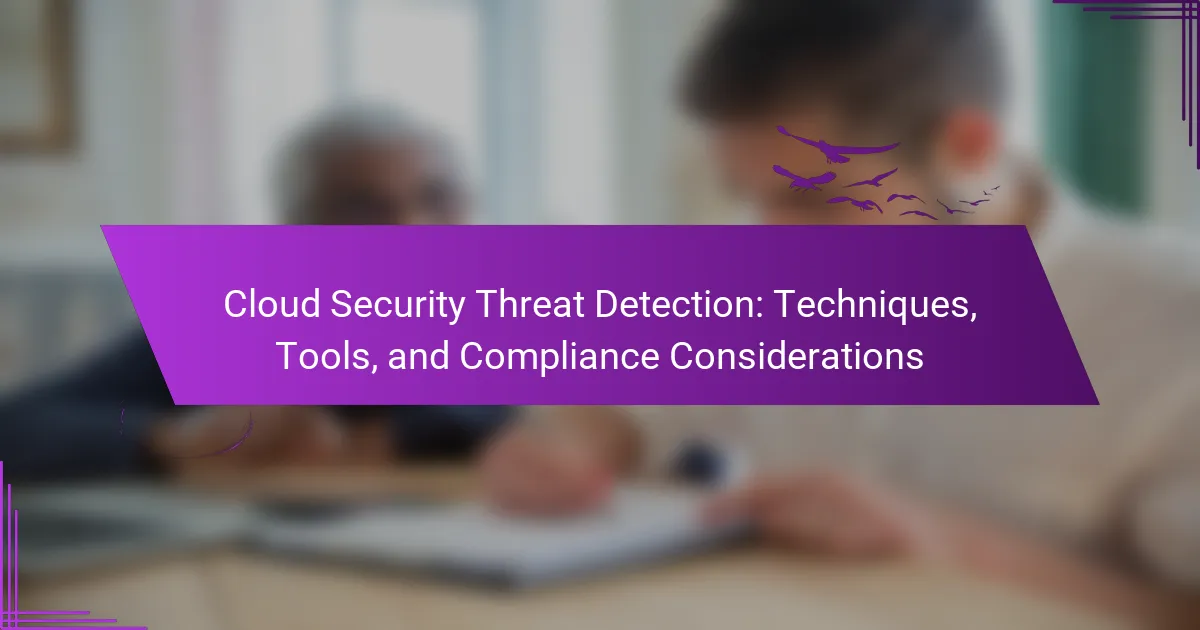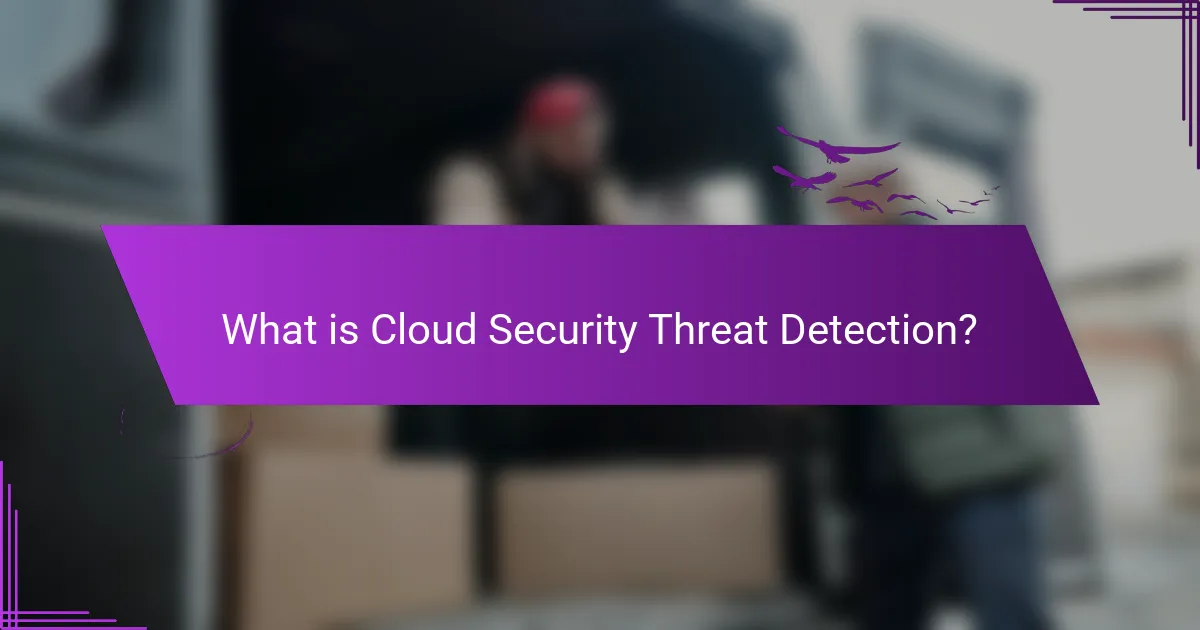
What is Cloud Security Threat Detection?
Cloud Security Threat Detection refers to the processes and technologies used to identify potential security threats within cloud environments. It involves monitoring cloud systems for unusual activities that may indicate breaches or attacks. These systems utilize various tools and techniques, such as machine learning algorithms and behavior analysis, to detect anomalies. According to a report by Gartner, 60% of organizations will prioritize cloud security threat detection in their security strategies by 2025. This emphasizes the growing importance of proactive threat detection in safeguarding cloud infrastructures.
How does Cloud Security Threat Detection function?
Cloud Security Threat Detection functions by identifying and mitigating potential security risks in cloud environments. It utilizes various techniques such as anomaly detection, signature-based detection, and machine learning algorithms. Anomaly detection examines user behavior and system activities to identify deviations from normal patterns. Signature-based detection relies on known threat signatures to detect malicious activities. Machine learning algorithms analyze large datasets to predict potential threats based on historical data. These methods work together to enhance the security posture of cloud services. Effective threat detection is crucial, as cloud environments are increasingly targeted by cyberattacks. According to a report by Cybersecurity Ventures, global cybercrime costs are expected to reach $10.5 trillion annually by 2025, highlighting the need for robust threat detection systems.
What are the key components of Cloud Security Threat Detection?
The key components of Cloud Security Threat Detection include monitoring, detection algorithms, response mechanisms, and reporting tools. Monitoring involves continuous observation of cloud environments for unusual activities. Detection algorithms analyze data patterns to identify potential threats. Response mechanisms initiate actions to mitigate detected threats. Reporting tools provide insights into security incidents and system vulnerabilities. These components work together to enhance the overall security posture of cloud environments.
How do these components interact to identify threats?
Components in cloud security threat detection interact through data analysis, machine learning, and threat intelligence. Data analysis collects and processes logs from multiple sources. This data is then analyzed for patterns that indicate potential threats. Machine learning algorithms enhance detection by learning from historical threat data. They identify anomalies that deviate from normal behavior. Threat intelligence feeds provide real-time data on emerging threats. This information is integrated into detection systems to improve accuracy. Together, these components create a comprehensive threat detection framework. This framework adapts to evolving threats, ensuring proactive security measures.
Why is Cloud Security Threat Detection important?
Cloud security threat detection is important because it identifies and mitigates potential security breaches in cloud environments. Effective detection prevents data loss and unauthorized access to sensitive information. According to a report by McAfee, 52% of organizations experienced a cloud security incident in the past year. This statistic highlights the growing risks associated with cloud computing. Additionally, threat detection helps organizations comply with regulatory requirements, such as GDPR and HIPAA. Compliance reduces the risk of hefty fines and legal issues. Overall, proactive threat detection enhances the security posture of cloud services.
What are the potential consequences of inadequate threat detection?
Inadequate threat detection can lead to severe security breaches. Organizations may experience data loss and theft, impacting business operations. Financial losses can occur due to fraud or recovery efforts. Regulatory penalties may arise from non-compliance with data protection laws. Reputational damage can result in loss of customer trust and market position. Increased vulnerability to future attacks can be a long-term consequence. A study by IBM found that the average cost of a data breach is $3.86 million, highlighting the financial impact of inadequate detection.
How does effective threat detection enhance cloud security?
Effective threat detection enhances cloud security by identifying and mitigating potential risks in real-time. It allows organizations to monitor their cloud environments continuously. This proactive approach helps in recognizing suspicious activities early. Early detection reduces the chances of data breaches and unauthorized access. According to a report by Cybersecurity Ventures, companies that implement effective threat detection can reduce incident response times by up to 90%. This rapid response minimizes the impact of security incidents. Furthermore, effective threat detection tools utilize machine learning algorithms to analyze patterns and anomalies. This advanced analysis improves overall security posture and compliance with regulations.
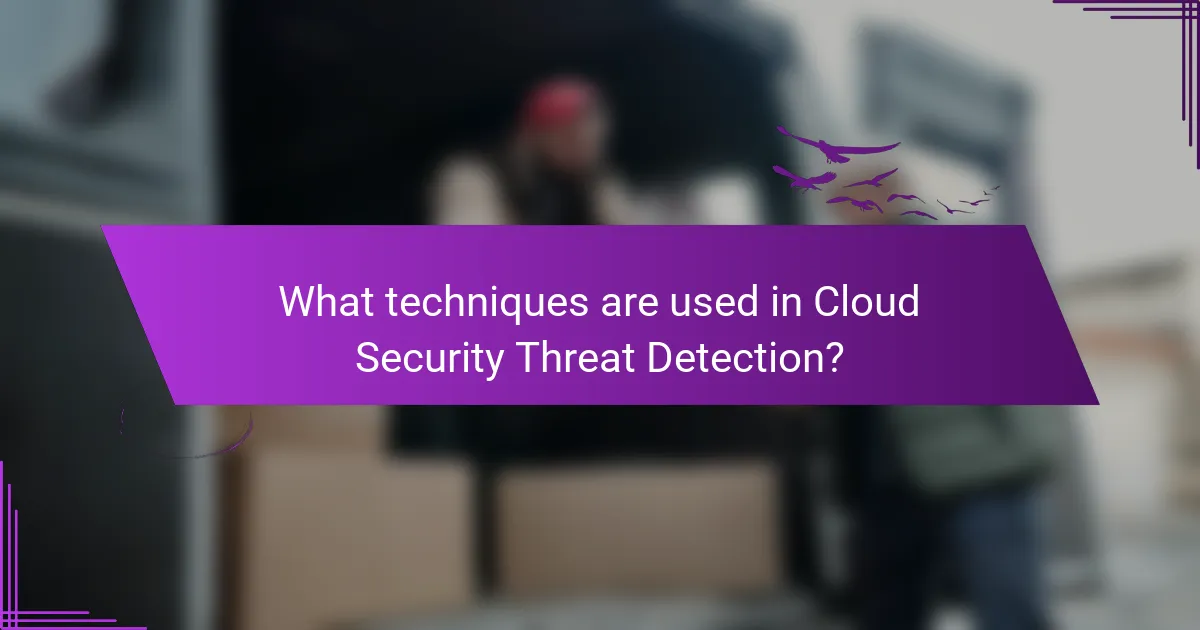
What techniques are used in Cloud Security Threat Detection?
Techniques used in Cloud Security Threat Detection include anomaly detection, signature-based detection, and behavior analysis. Anomaly detection identifies deviations from normal patterns in cloud traffic or user behavior. Signature-based detection relies on known threat signatures to identify malicious activities. Behavior analysis monitors user and entity behavior for unusual actions that may indicate a threat. Machine learning algorithms enhance detection capabilities by learning from historical data. These techniques collectively improve the accuracy and speed of threat detection in cloud environments.
How do machine learning algorithms contribute to threat detection?
Machine learning algorithms enhance threat detection by analyzing large datasets for patterns indicative of security threats. They can process data at high speeds, identifying anomalies that traditional methods might miss. For example, machine learning can detect unusual login attempts or data access patterns in real time. These algorithms learn from historical data, improving their accuracy over time. Research indicates that machine learning can reduce false positives by up to 50%, making threat detection more efficient. Additionally, algorithms can adapt to new threats as they emerge, providing ongoing protection. This adaptability is crucial in the rapidly evolving landscape of cloud security.
What types of machine learning models are commonly used?
Common types of machine learning models include supervised, unsupervised, and reinforcement learning models. Supervised models are trained using labeled data, allowing them to make predictions based on input-output pairs. Unsupervised models analyze data without labeled responses to uncover hidden patterns. Reinforcement learning models learn optimal actions through trial and error, receiving feedback from their environment. These models are widely used in various applications, including cloud security. For instance, supervised models can detect known threats, while unsupervised models can identify anomalies in network traffic. Reinforcement learning can optimize responses to security incidents in real-time.
How do these models improve detection accuracy?
These models improve detection accuracy by utilizing advanced algorithms and machine learning techniques. They analyze vast amounts of data in real-time to identify anomalies. This helps in recognizing patterns that indicate potential threats. The integration of artificial intelligence enhances predictive capabilities. Models can learn from previous incidents to refine their detection processes. They also reduce false positives through better classification of benign activities. Continuous updates ensure that models adapt to evolving threats. According to a study by IBM, AI-driven security systems can reduce detection times by up to 90%. This demonstrates their effectiveness in enhancing overall security measures.
What role does behavioral analysis play in threat detection?
Behavioral analysis plays a critical role in threat detection by identifying anomalous patterns in user and system behavior. It enables security systems to establish a baseline of normal activities. Deviations from this baseline can indicate potential threats or malicious activities. For example, sudden spikes in data access or unusual login times can trigger alerts. Research shows that behavioral analysis can reduce false positives significantly, improving the efficiency of threat detection systems. According to a study by the Ponemon Institute, organizations using behavioral analytics experienced a 30% decrease in security incidents. This demonstrates the effectiveness of behavioral analysis in enhancing overall security posture.
How is user behavior analyzed for threat identification?
User behavior is analyzed for threat identification through monitoring and analyzing patterns of activity. Security systems track user interactions with applications and data. They utilize machine learning algorithms to establish baseline behavior. Anomalies from this baseline indicate potential threats. For example, unusual login times or access to unauthorized data can trigger alerts. Behavioral analysis tools often correlate user actions with known threat intelligence. This helps in identifying and mitigating risks proactively. Studies show that organizations employing user behavior analytics reduce incident response times significantly.
What are the limitations of behavioral analysis in this context?
Behavioral analysis has several limitations in the context of cloud security threat detection. It can produce false positives, which may lead to unnecessary alerts and resource allocation. Behavioral analysis often relies on historical data, which may not accurately reflect current threats. Additionally, it may struggle to detect novel or sophisticated attacks that do not fit established patterns. The effectiveness of behavioral analysis can be hindered by data privacy concerns, limiting the data available for analysis. Furthermore, it may require significant computational resources, impacting system performance. These limitations highlight the need for complementary security measures in cloud environments.
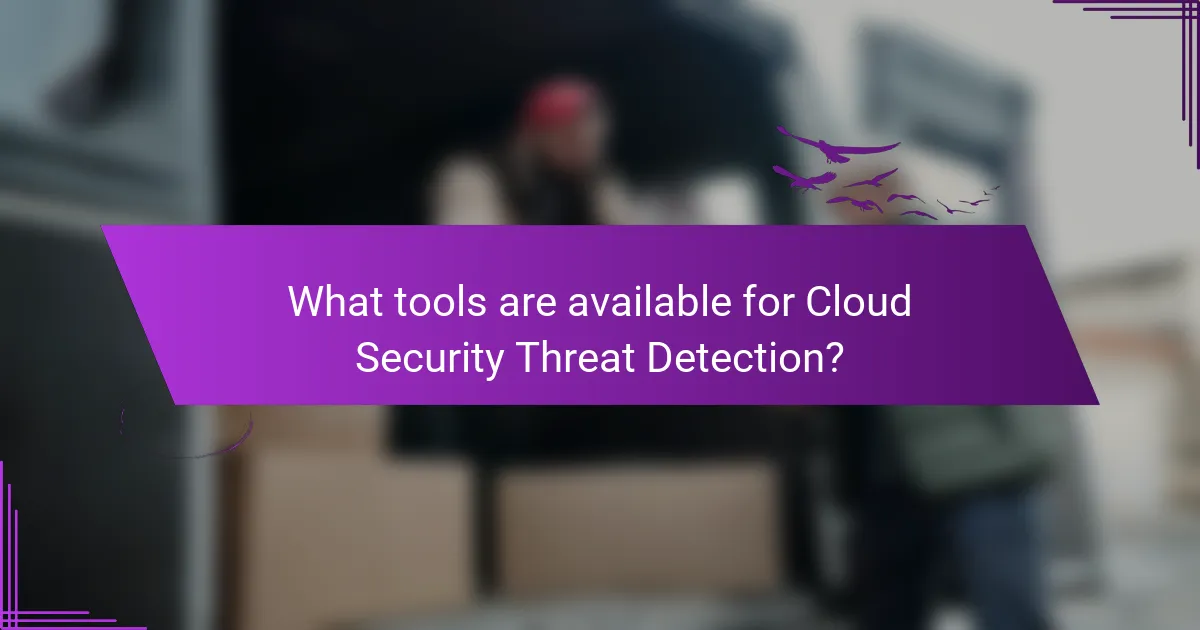
What tools are available for Cloud Security Threat Detection?
Cloud security threat detection tools include various software and services designed to identify potential security risks. Examples of these tools are Cloud Security Posture Management (CSPM) solutions, which monitor cloud configurations for vulnerabilities. Security Information and Event Management (SIEM) tools aggregate and analyze security data from cloud environments. Intrusion Detection Systems (IDS) are also used to detect unauthorized access or anomalies in cloud traffic. Additionally, Endpoint Detection and Response (EDR) tools monitor endpoints for suspicious activity. These tools help organizations maintain compliance and protect sensitive data in the cloud.
Which cloud security tools are most effective for threat detection?
The most effective cloud security tools for threat detection include AWS GuardDuty, Microsoft Azure Security Center, and Google Cloud Security Command Center. AWS GuardDuty utilizes machine learning to identify anomalous behavior and potential threats in real-time. Microsoft Azure Security Center provides integrated threat detection and response capabilities across Azure workloads. Google Cloud Security Command Center offers visibility into security risks and vulnerabilities across Google Cloud services. These tools leverage advanced analytics and machine learning to enhance threat detection accuracy and speed.
What features should be considered when choosing a tool?
When choosing a tool for cloud security threat detection, consider scalability, integration capabilities, and user-friendliness. Scalability ensures the tool can handle increased data loads as your cloud environment grows. Integration capabilities allow the tool to work seamlessly with existing systems and security solutions. User-friendliness is crucial for efficient operation and quick adoption by team members. Additionally, look for real-time monitoring features, automated threat response, and comprehensive reporting functionalities. Real-time monitoring helps in timely detection of threats. Automated threat response can mitigate risks faster. Comprehensive reporting aids in compliance and audits. These features collectively enhance the effectiveness of cloud security threat detection tools.
How do these tools integrate with existing cloud infrastructures?
These tools integrate with existing cloud infrastructures by utilizing APIs and standardized protocols. They enable seamless data exchange and communication with cloud services. Tools can deploy agents on cloud resources for real-time monitoring. They also leverage cloud-native services for scalability and efficiency. Integration often involves configuring security policies within the cloud environment. Many tools offer dashboards for centralized visibility across platforms. This integration enhances threat detection capabilities. According to a 2022 report by Gartner, organizations using integrated tools experienced a 30% reduction in incident response time.
What are the differences between open-source and commercial tools?
Open-source tools are software solutions with source code that anyone can inspect, modify, and enhance. In contrast, commercial tools are proprietary software that requires a purchase or subscription for use. Open-source tools often have a community-driven development model, allowing for collaborative improvements and transparency. Commercial tools typically offer dedicated customer support and regular updates from the vendor.
Open-source tools can be more cost-effective, as they are usually free to use. However, they may lack the polished user experience and features found in commercial solutions. Commercial tools often come with guaranteed service levels and compliance assurances, which can be critical in regulated industries.
According to a study by Gartner, the total cost of ownership for open-source tools can be lower over time, but initial setup and maintenance may require more technical expertise. Conversely, commercial tools often provide a more straightforward implementation process, catering to organizations with limited IT resources.
What are the advantages of using open-source tools?
Open-source tools offer several advantages. They are typically free to use, which reduces costs for organizations. Open-source software allows users to modify the source code. This flexibility enables customization to meet specific needs. Community support is often robust, providing access to a wealth of knowledge and resources. Many open-source tools are regularly updated, enhancing security and functionality. Transparency in open-source tools allows for better security auditing. Users can identify vulnerabilities more easily than in closed-source alternatives. These benefits make open-source tools a popular choice in cloud security threat detection.
How do commercial tools provide additional benefits?
Commercial tools enhance cloud security by offering advanced threat detection capabilities. They utilize machine learning algorithms to analyze large data sets for anomalies. This process improves the accuracy of identifying potential threats. Many commercial tools also provide real-time monitoring, allowing for immediate response to incidents. They often include automated compliance reporting features. These features help organizations meet regulatory requirements efficiently. Additionally, commercial tools typically offer customer support and regular updates. This ensures that users have access to the latest security measures and best practices. Overall, these benefits lead to a more robust security posture for cloud environments.
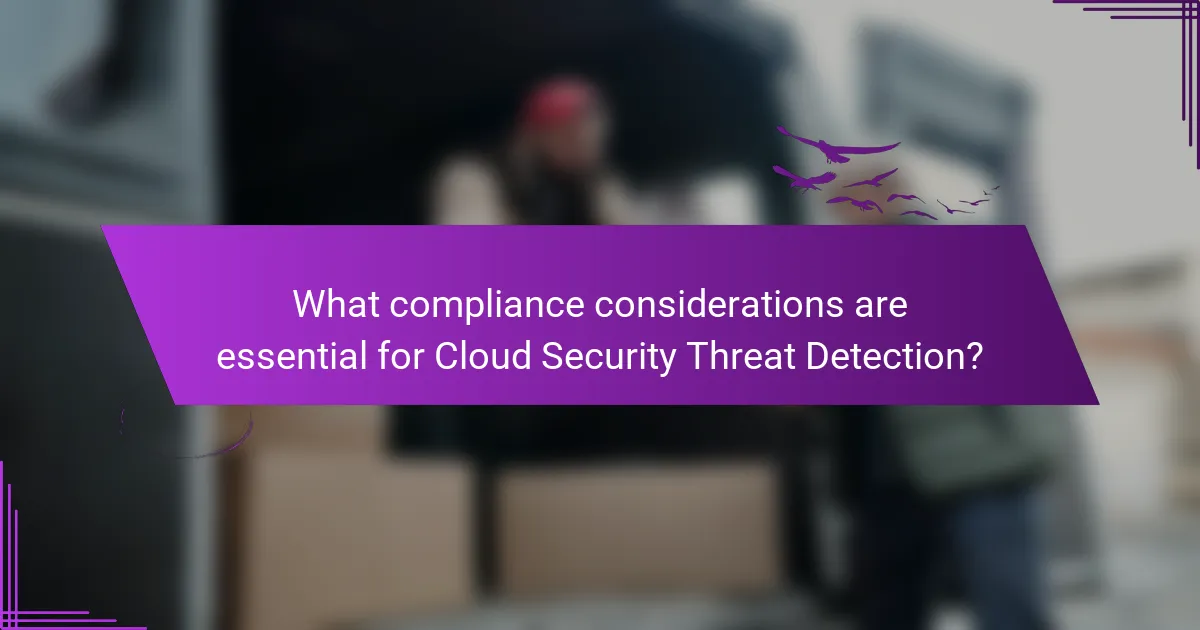
What compliance considerations are essential for Cloud Security Threat Detection?
Essential compliance considerations for Cloud Security Threat Detection include data protection regulations and industry standards. Organizations must adhere to regulations like GDPR, HIPAA, and PCI DSS. These regulations dictate how sensitive data should be handled and protected. Compliance ensures that organizations implement necessary security measures to safeguard data. Additionally, regular audits and assessments are crucial for maintaining compliance. Organizations should also establish incident response plans to address potential security breaches. This proactive approach aligns with compliance requirements and enhances overall security posture. Finally, training employees on compliance protocols is essential for effective threat detection and response.
How do regulations impact threat detection practices in the cloud?
Regulations significantly influence threat detection practices in the cloud. They establish compliance requirements that organizations must follow. For instance, the General Data Protection Regulation (GDPR) mandates data protection and privacy. This leads to enhanced monitoring and reporting mechanisms for cloud providers. Regulations often require regular audits and assessments of security practices. Such mandates ensure that threat detection tools are up-to-date and effective. Additionally, specific industries may have unique regulations that shape threat detection strategies. For example, the Health Insurance Portability and Accountability Act (HIPAA) requires stringent data security measures in healthcare. Compliance with these regulations drives investment in advanced threat detection technologies. Ultimately, regulations create a framework that prioritizes security and mitigates risks in cloud environments.
What are the key regulations that organizations must comply with?
Key regulations organizations must comply with include the General Data Protection Regulation (GDPR), Health Insurance Portability and Accountability Act (HIPAA), and the Payment Card Industry Data Security Standard (PCI DSS). GDPR mandates data protection and privacy for individuals within the European Union. HIPAA regulates the handling of protected health information in the healthcare sector. PCI DSS sets security standards for organizations that handle credit card transactions. Compliance with these regulations is essential to avoid legal penalties and protect sensitive information. Organizations often face significant fines for non-compliance, such as GDPR fines reaching up to 4% of annual global turnover.
How can organizations ensure compliance while implementing detection techniques?
Organizations can ensure compliance while implementing detection techniques by aligning their practices with regulatory standards. They should conduct a thorough risk assessment to identify applicable regulations. Regular audits can help verify adherence to these standards. Training staff on compliance requirements is essential for effective implementation. Utilizing automated compliance tools can streamline monitoring efforts. Documentation of processes and findings aids in demonstrating compliance. Engaging with legal and compliance experts provides additional assurance. Following these measures helps organizations maintain compliance during the implementation of detection techniques.
What best practices should be followed for compliance in threat detection?
Best practices for compliance in threat detection include implementing a robust security framework. Organizations should regularly assess risks and vulnerabilities. Continuous monitoring of systems is essential for timely threat identification. Data encryption protects sensitive information during transmission and storage. Establishing incident response plans ensures quick action against detected threats. Regular training for staff on compliance and security protocols enhances awareness. Documentation of all compliance measures supports audits and regulatory requirements. Adhering to industry standards, such as ISO 27001, reinforces security practices and compliance.
How can continuous monitoring support compliance efforts?
Continuous monitoring enhances compliance efforts by providing real-time visibility into security controls. It allows organizations to identify and address compliance gaps promptly. Automated alerts can notify teams of potential violations immediately. This proactive approach reduces the risk of non-compliance penalties. Continuous monitoring also ensures that security policies are enforced consistently across systems. According to a study by the Ponemon Institute, organizations with continuous monitoring reduce the average time to detect a data breach by 27%. This efficiency supports regulatory compliance by demonstrating due diligence in security practices.
What role does employee training play in maintaining compliance?
Employee training is essential for maintaining compliance within organizations. It ensures that employees understand regulations and policies relevant to their roles. Regular training updates employees on new compliance requirements. This knowledge helps prevent violations and reduces legal risks. According to a study by the Aberdeen Group, companies with effective training programs experience 50% fewer compliance issues. Training also fosters a culture of accountability and responsibility. Employees are more likely to report suspicious activities when they are informed. Overall, comprehensive training is a proactive strategy for compliance management.
What are the common challenges in Cloud Security Threat Detection?
Common challenges in cloud security threat detection include data complexity, lack of visibility, and dynamic environments. Data complexity arises from the vast amount of data generated in cloud environments. This makes it difficult to identify and analyze potential threats effectively. Lack of visibility refers to the limited insight into user activities and data flows across cloud services. It complicates the detection of unauthorized access or anomalies. Dynamic environments present challenges due to the constant changes in cloud infrastructure. These changes can introduce new vulnerabilities that may go unnoticed. Additionally, the integration of multiple cloud services can lead to inconsistent security policies. This inconsistency can hinder effective threat detection and response.
How can organizations overcome these challenges effectively?
Organizations can overcome cloud security challenges effectively by implementing multi-layered security strategies. They should utilize advanced threat detection tools that leverage artificial intelligence and machine learning. Regularly updating software and systems is crucial to address vulnerabilities. Employee training programs on security best practices can reduce human error. Conducting routine security audits helps identify potential weaknesses. Establishing a robust incident response plan prepares organizations for potential breaches. Compliance with industry standards, such as ISO 27001, enhances security posture. These measures collectively strengthen an organization’s ability to detect and respond to threats in the cloud environment.
What strategies can be employed to enhance detection capabilities?
Implementing advanced analytics and machine learning algorithms can enhance detection capabilities. These technologies analyze vast amounts of data in real-time. They identify patterns and anomalies that may indicate security threats. Regularly updating detection systems improves their accuracy. This ensures they can recognize new types of threats. Integrating threat intelligence feeds provides context for potential risks. Organizations can proactively respond to emerging threats by using this information. Conducting regular security assessments helps identify weaknesses in detection processes. This allows for continuous improvement and adaptation to evolving threats.
What practical tips can improve Cloud Security Threat Detection?
Implementing robust cloud security threat detection involves several practical tips. First, adopt a multi-layered security approach. This includes firewalls, intrusion detection systems, and encryption. Regularly updating software and security protocols is essential. Outdated systems are more vulnerable to attacks.
Utilize machine learning algorithms for anomaly detection. These algorithms can identify unusual patterns in data traffic. Conduct regular security audits to assess vulnerabilities. This proactive measure helps in identifying weaknesses before they are exploited.
Establish a comprehensive incident response plan. This plan should outline steps to take when a threat is detected. Training staff on security best practices is crucial. Human error often contributes to security breaches.
Finally, leverage threat intelligence feeds. These feeds provide real-time information on emerging threats. They enhance the ability to detect and respond to potential attacks swiftly.
Cloud Security Threat Detection is the process and technology used to identify potential security threats within cloud environments, utilizing techniques such as anomaly detection, machine learning, and behavior analysis. The article covers the functioning of threat detection systems, key components, and the importance of effective detection in preventing data breaches and ensuring compliance with regulations like GDPR and HIPAA. It also examines various tools available for threat detection, including commercial and open-source options, and highlights best practices and strategies to enhance detection capabilities while addressing common challenges faced in cloud security.
